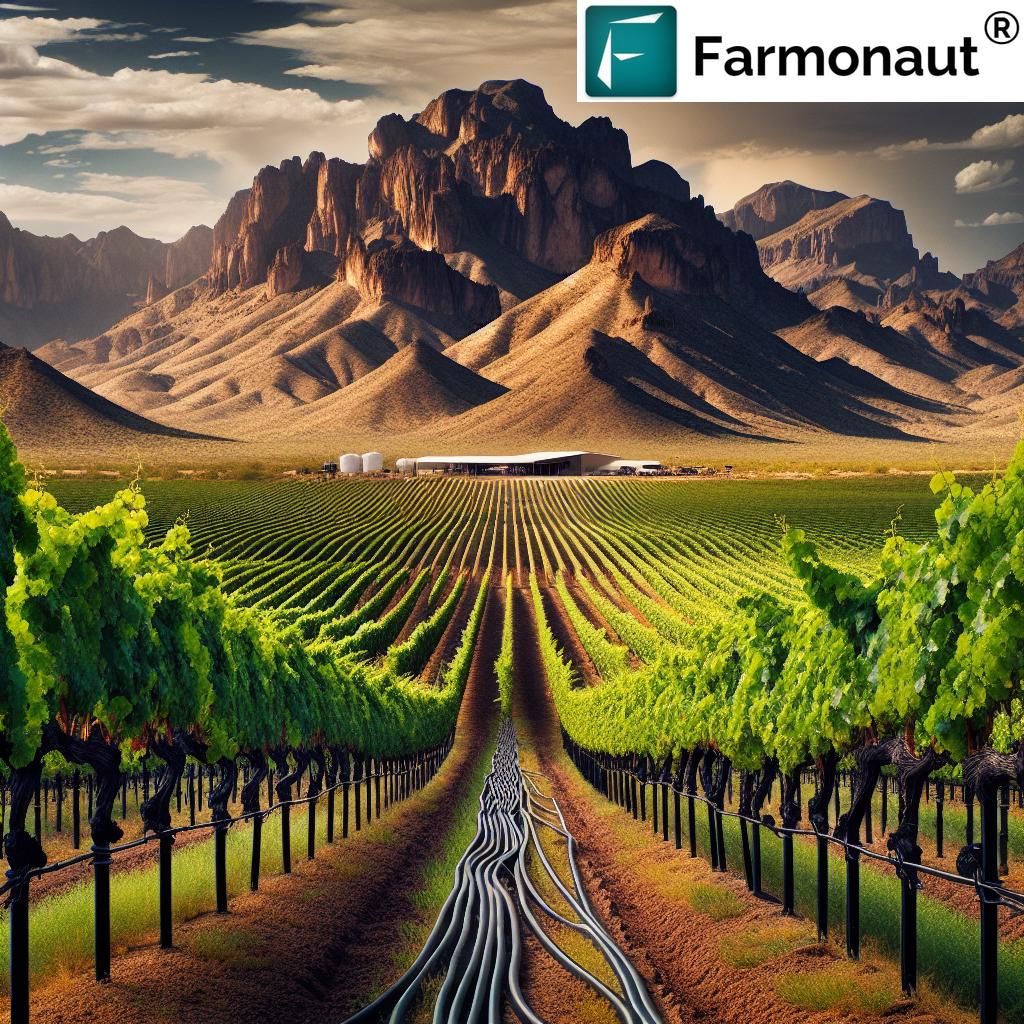Unlocking Arizona’s Desert Viticulture: Mastering High Desert Farming Techniques for Thriving Vineyards
“Arizona’s Sonoita AVA vineyards thrive in rocky soil at elevations up to 5,000 feet, producing award-winning cool climate wines.”
Welcome to our inspiring journey through the world of Arizona vineyard management and desert viticulture techniques. We’re about to embark on an exciting exploration of high desert farming that will transform your perception of wine grape cultivation in the arid Southwest. From rocky soil to award-winning wines, we’ll uncover the secrets of how one couple’s passion turned 40 acres in the Sonoita AVA into a thriving vineyard, showcasing the unique aspects of Arizona wine country.

The Birth of a Dream: From Weekend Hobby to Thriving Vineyard
Our story begins with a couple’s weekend hobby that blossomed into a full-fledged second career. We were drawn to the rugged beauty of the Sonoita region, nestled between the Santa Rita, Huachuca, and Whetstone mountains. The landscape, with its rolling grasslands and dramatic mountain vistas, spoke to our souls and sparked a vision of rows upon rows of grapevines stretching across the high desert plateau.
Little did we know that our 40 acres of seemingly inhospitable land would become a testament to the potential of Arizona’s wine country. The journey from novice enthusiasts to successful vintners was fraught with challenges, but it was this very adversity that fueled our passion and drove us to master the art of desert viticulture.
Understanding the Unique Terroir of Arizona’s High Desert
To truly appreciate the marvel of Arizona vineyard management, one must first understand the unique terroir of the region. The Sonoita AVA (American Viticultural Area) is characterized by its high elevation, ranging from 4,500 to 5,000 feet above sea level. This altitude plays a crucial role in creating the cool climate viticulture that sets Arizona wines apart.
- Soil Composition: The rocky, well-draining soil of the region, while challenging, provides excellent conditions for stressing the vines—a key factor in producing high-quality grapes.
- Climate: The high desert experiences dramatic diurnal temperature swings, with hot days and cool nights that help preserve acidity in the grapes while allowing for full flavor development.
- Sunlight: Arizona boasts an abundance of sunny days, providing ample photosynthesis for the vines, which translates to robust grape growth and sugar development.
These unique conditions create a perfect storm for wine grape cultivation, allowing us to produce wines with a distinct character that reflects the essence of the Arizona terroir.
Overcoming the Challenges of Desert Viticulture
Cultivating a vineyard in the high desert comes with its own set of challenges. We quickly learned that success in this environment requires a blend of traditional winemaking knowledge and innovative desert farming techniques. Here are some of the key challenges we faced and the solutions we implemented:
Water Management: The Lifeline of Desert Viticulture
In a region where water is precious, efficient irrigation is paramount. We turned to advanced drip irrigation for vineyards, a technique that has revolutionized our water management:
- Precision watering directly to the root zone
- Reduced water evaporation
- Ability to control nutrient delivery through fertigation
By implementing these sustainable vineyard practices, we’ve not only conserved water but also improved the health and yield of our vines.
Explore Farmonaut’s advanced agricultural solutions:
Soil Management: Turning Rocky Ground into Fertile Vineyard
The rocky soil of Sonoita presented both a challenge and an opportunity. While initially daunting, we discovered that this soil composition could be a boon for wine production when managed correctly:
- Incorporating organic matter to improve soil structure
- Using cover crops to prevent erosion and add nutrients
- Implementing careful tillage practices to maintain soil health
These vineyard soil management techniques have transformed our once-barren land into a thriving ecosystem for our vines.
Climate Adaptation: Embracing the High Desert Environment
The extreme temperature fluctuations of the high desert required us to adopt specific strategies to protect our vines:
- Selecting grape varieties suited to cool climate viticulture
- Using wind machines to mitigate frost risk
- Employing canopy management techniques to protect grapes from sunburn
By working with nature rather than against it, we’ve created a vineyard that thrives in its unique environment.
The Art and Science of Winemaking in Arizona
Winemaking in Arizona is a delicate balance of art and science. Our journey from seeding to production has taught us valuable lessons about the unique aspects of producing wine in this region:
Grape Selection: Choosing Varieties That Thrive
Selecting the right grape varieties is crucial for success in Arizona’s climate. We’ve found success with:
- Red varieties: Syrah, Grenache, and Tempranillo
- White varieties: Viognier, Malvasia Bianca, and Vermentino
These grapes have shown remarkable adaptability to our terroir, producing wines with complex flavors and balanced acidity.
Harvesting: Timing is Everything
The unique climate of Arizona wine country means that harvest timing is critical. We closely monitor:
- Sugar levels (Brix)
- Acid balance
- Phenolic ripeness
Often, we find ourselves harvesting in the cool predawn hours to preserve the delicate balance of flavors in our grapes.
“The Gardners transformed 40 acres of harsh desert landscape into a thriving vineyard, showcasing the potential of Arizona’s wine country.”
Winemaking Techniques: Adapting to Desert Grapes
Our winemaking process has evolved to highlight the unique characteristics of our desert-grown grapes:
- Gentle pressing to preserve delicate flavors
- Temperature-controlled fermentation to maintain aromatic profiles
- Judicious use of oak to complement, not overpower, the fruit
These techniques allow us to produce wines that truly express the essence of Arizona terroir.
Sustainable Practices: Nurturing the Land for Future Generations
As stewards of the land, we’ve made a commitment to sustainable vineyard practices that not only produce exceptional wines but also preserve the delicate desert ecosystem:
- Integrated Pest Management (IPM) to reduce chemical interventions
- Solar power utilization for winery operations
- Water recycling and conservation measures
These practices not only benefit the environment but also contribute to the overall quality of our wines.

The Future of Arizona Wine Country
As we look to the future, we’re filled with optimism about the potential of Arizona’s wine industry. The Sonoita AVA and other emerging wine regions in the state are gaining recognition for producing world-class wines that reflect their unique terroir.
We’re excited to be part of this growing community of passionate vintners who are pushing the boundaries of what’s possible in desert viticulture. With continued innovation and dedication to quality, we believe that Arizona wines will soon be recognized alongside the great wine regions of the world.
Explore Farmonaut’s mobile apps for on-the-go farm management:
Embracing Technology in Vineyard Management
In our quest to perfect desert viticulture techniques, we’ve found that embracing cutting-edge technology can make a significant difference. Tools like Farmonaut’s satellite-based crop monitoring system have revolutionized the way we manage our vineyard:
- Real-time crop health monitoring
- Precise irrigation management
- Early detection of pest and disease issues
By leveraging these advanced technologies, we’re able to make data-driven decisions that improve our grape quality and overall vineyard health.
For developers interested in integrating agricultural data into their applications, explore Farmonaut’s API and API Developer Docs.
The Joy of Cultivating Vines Under the Arizona Sun
Despite the challenges, there’s an indescribable joy in nurturing vines under the abundant Arizona sunlight. Each day brings new discoveries and a deeper connection to the land. We’ve found that the process of cultivating grapes in this unique environment has not only produced exceptional wines but has also cultivated in us a profound respect for nature’s resilience.
The cool evenings that follow scorching days create a natural balance, allowing our grapes to develop complex flavors while retaining their crucial acidity. This diurnal temperature variation is a vintner’s dream, and we’ve learned to harness its power to create wines of distinction.
A Comparative Look at Desert Viticulture
To better understand the unique aspects of Arizona desert viticulture, let’s compare traditional techniques with those we’ve adapted for our high desert environment:
| Viticulture Aspect | Traditional Technique | Arizona Desert Technique |
|---|---|---|
| Irrigation | Flood irrigation or sprinklers | Precision drip irrigation systems |
| Soil Management | Conventional fertilization | Organic matter incorporation, cover crops |
| Grape Varieties | Classic European varietals | Drought-resistant and heat-tolerant cultivars |
| Climate Adaptation | Frost protection, moderate sun exposure | Heat mitigation, UV protection techniques |
| Harvest Timing | Based primarily on sugar levels | Balance of sugar, acid, and phenolic ripeness |
Lessons Learned: Advice for Aspiring Desert Vintners
For those inspired to embark on their own desert viticulture journey, we offer these hard-earned pieces of advice:
- Patience is key: Desert vines take time to establish deep root systems.
- Embrace the terroir: Work with the unique aspects of your land rather than against them.
- Continuous learning: Stay open to new techniques and technologies in vineyard management.
- Community matters: Build relationships with other local vintners and agricultural experts.
- Sustainability focus: Implement practices that will preserve the land for future generations.
Conclusion: The Fruits of Our Labor
Our journey from a weekend hobby to a thriving vineyard in the heart of Arizona’s wine country has been one of passion, perseverance, and continuous learning. We’ve discovered that the challenges of desert viticulture are not obstacles but opportunities for innovation and growth.
As we look out over our rows of vines, heavy with ripening grapes under the azure Arizona sky, we’re filled with a sense of accomplishment and excitement for the future. Each vintage tells a story of our land, our climate, and our dedication to crafting wines that truly represent the spirit of the high desert.
We invite you to explore the world of Arizona wines, to taste the sunshine, the cool nights, and the rocky soils in each glass. Whether you’re a wine enthusiast or an aspiring vintner, remember that with passion and dedication, even the most challenging landscapes can yield beautiful results.
Cheers to the adventure of desert viticulture and the endless possibilities it holds!
FAQs About Arizona Desert Viticulture
- Q: What makes Arizona’s wine country unique?
A: Arizona’s high elevation, dramatic temperature swings, and mineral-rich soils create a unique terroir that produces distinctive wines with excellent acidity and complex flavors. - Q: How do desert vineyards manage water scarcity?
A: Desert vineyards utilize efficient drip irrigation systems, moisture sensors, and drought-resistant grape varieties to maximize water use efficiency. - Q: What grape varieties thrive in Arizona’s climate?
A: Varieties like Syrah, Grenache, Tempranillo, Viognier, and Malvasia Bianca have shown great success in Arizona’s climate. - Q: How does the high desert climate affect wine production?
A: The high desert climate, with its hot days and cool nights, allows for extended hang time on the vine, resulting in grapes with intense flavors and balanced acidity. - Q: What sustainable practices are common in Arizona vineyards?
A: Many Arizona vineyards employ sustainable practices such as integrated pest management, solar power utilization, and water conservation techniques.
Explore Farmonaut’s Subscription Options
Embarking on your own vineyard journey? Farmonaut’s advanced agricultural solutions can help you navigate the challenges of desert viticulture with precision and ease. Explore our subscription options to find the perfect fit for your vineyard management needs.






